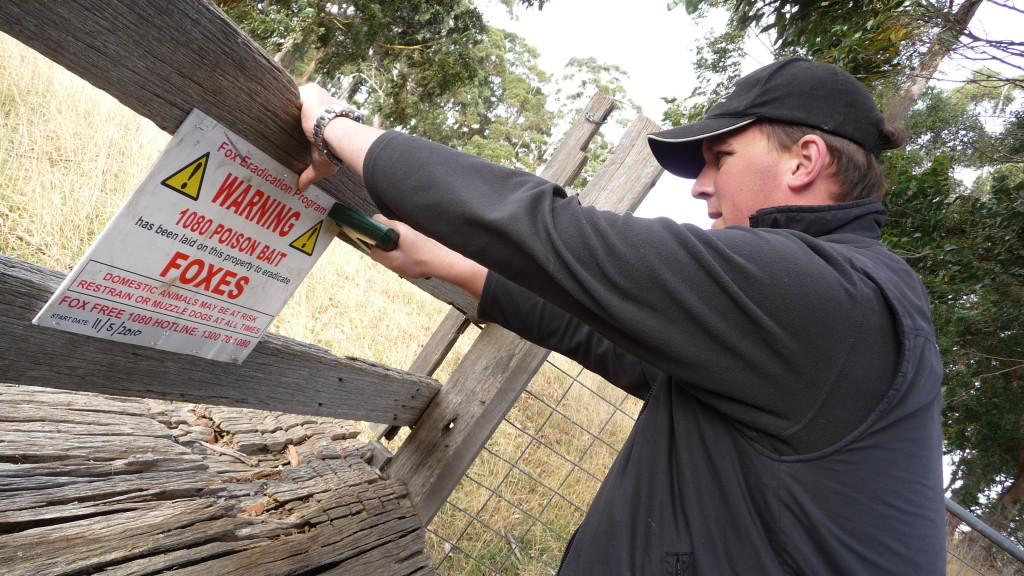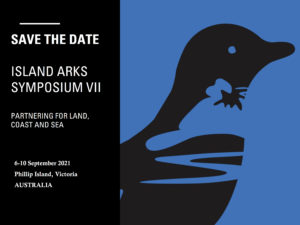Are there foxes in Tasmania? The answer to that question is a point of contention in the island state. European red foxes (Vulpes vulpes) are an invasive species that could severely damage the biodiversity of Tasmania.
Craig Elliott from Tasmania’s Department of Primary Industries, Parks, Water and Environment answers Yes, there are foxes in Tasmania. Elliott manages the Fox Eradication Program. He has responded in detail to questions on the program from Island Arks below.

Fox Eradication Program officer collects carnivore scat during monitoring in NW. Photo courtesy DPIPWE.
Island Arks: What have been the successes of the Fox Eradication Program in the last 12 months?
Craig Elliott: The Fox Eradication Program has been going through a number of changes in the past year. A key part of this has been our approach to planning the baiting program and how we respond to public sightings.
Planning the baiting activities is a huge effort. We can be dealing with well over a thousand different properties at any given time. First we make initial contact with property owners in advance of our baiting front to raise awareness of the eradication program and our timelines. Then we confirm the detail of our plan at the property level through to placing and retrieving baits. Finally we organise and complete the follow-up monitoring. Managing that amount of data and the logistics of the operational activity can be time consuming and complex.
Our increase in output in the past year can be attributed to the recruitment of specialist Planning Officers to work alongside Operations staff as well as the improved management of spatial information. In the early stages of the broadscale precautionary strategy, the Fox Eradication Program was covering about 100 000 ha per annum. During 2012, with Planning Officers and improved spatial information management in place, we saw an increase of over 250% in that coverage.
We also brought in a new framework to manage our responses to possible sightings of foxes in Tasmania. We average approximately 5 to 6 sightings per week and it is important that we prioritise those reports in order to get the best outcome. All reports received are prioritised based on location – highest priority goes to areas where we have completed baiting and monitoring to make sure we sustain the eradication in those areas – and we now approach every public sighting as a new incursion and respond under a two-stage framework.
When we receive a public sighting, field staff initially speak with the witness to confirm the details of the sighting and confirm the likelihood of the sighting being accurate. Accuracy is based on an eight-point assessment that covers everything from the ‘visibility’ of the area to the distance from which the animal was seen to the witness’ knowledge of foxes. The assessment also takes into consideration the description of the animal and its behaviour.
If the report appears to be accurate, and it is in a priority area, a Detector Dog team and monitoring cameras will most likely be deployed. This is the first stage.
If physical evidence, such as a fox scat or tracks, are discovered, our responses progresses to the second stage where team is sent to locate and destroy the animal.
We adopted many of the same principles and processes used in emergency animal disease responses. In addition to physical searches, the response team considers the need for public information and forward planning required to provide a rigorous response.
Program growth and improved information management was achieved during a period of major organisational change. The Fox Eradication Program was amalgamated with other parts of the Department to form an Invasive Species Branch with responsibilities for the broad range of invasive animal and weed threats that face Tasmania. Underpinning this is the importance of effectively recruiting and ensuring staff have the support they need as they go through these changes while also managing the pressures of their ‘normal’ jobs.
Fox Eradication Program fox tracking dog (Boss, German Short-haired Pointer). Photo courtesy DPIPWE.
Island Arks: What is the biggest misconception about the program?
Craig Elliott: It can be summed up in the question “Where are the foxes?”. The biggest misconception is that if the everyday person in the street doesn’t see foxes running about then there must not be any foxes in Tasmania. It no longer surprises me when I encounter people who aren’t aware of the facts and the evidence underpinning the eradication program. Some people aren’t aware of the fox carcasses or other evidence such as scats; or they may reject that type of evidence on the basis that they haven’t personally seen a fox in Tasmania.
There is a lot of history and misinformation about the program and that makes it hard for people to understand it and what is has achieved. The last stages of an eradication are always difficult. Eradicating foxes in Tasmania is even more difficult as we work alongside a community who may have be relying on misinformation or myths about the program and then being reluctant to support the effort.
The biggest issue the need to deal with the misconception that if an eradication program is needed, foxes will be widespread and being seen everywhere. After ten years of trying to eradicate them, including the past three under the current strategic landscape approach, explaining the fact that not seeing foxes is a sign of success can be difficult.
Island Arks: How have previous eradication programs served as models for the Fox Eradication Program?
Craig Elliott: The Fox Eradication Program has been a challenge on many fronts: running an operation across an island of over 68 000 km2, addressing a degree of community fatigue with a long-term program and dealing with pockets of opposition. The scepticism about the need for the program commenced before any impacts were being observed. We’ve learnt many lessons the hard way, through trial and error, as well as lessons from other programs.
Previous programs have all added to the body of knowledge that is being used, especially from the technical aspects for operational areas like baiting and the use of Detector Dogs, but the Fox Eradication Program has had to break a lot of new ground. It has often seen us drawing on other fields, such as the lessons learnt in community engagement for other types of programs and the lessons learnt in biosecurity responses to animal disease outbreaks, to guide how we design and deliver the various components that make up the Fox Eradication Program.
Island Arks: How do you respond to people who have doubts about the program?
Craig Elliott: You have to accept that not everyone will ever agree with the program; whether be the justification for it, the length of time the eradication is taking, or its approach and use of toxins.
It is interesting though to delve into why people will have doubts and our surveys find that generally it relates back to whether the person with the doubts has ever personally seen, or knows someone they trust who has seen, a fox in Tasmania or not. We can often see those doubts being removed when the evidence of foxes in Tasmania is explained. We equate the current situation to one where the fox would be regarded as ‘critically endangered’ if it was a native species.
Unfortunately, that requires a lot of one-on-one communication to counter those doubts. A recent paper by the University of Canberra (Blackman, Corcoran and Sarre (2013) “Are there really foxes: Where does the doubt emerge?” Journal of Knowledge Management Practice Vol 14, No 1, March 2013) went into more detail about this and it proposes a few points in time where doubt began to emerge in the minds of some people.
Acknowledging these issues has been important for us and has helped frame how Fox Eradication Program material is developed and promoted as well as how the Fox Eradication Program operates. Perception is a difficult issue to manage. It is important that any program expending public monies is critically self-aware of how it is perceived and how it can demonstrate its professionalism and value.
Further reading
- Are there really foxes: Where does the doubt emerge? by Blackman et. Al via Social Science Research Network.
- Fox eradication program underway from ABC Rural
- Foxes in Tasmania from Tasmania’s Department of Primary Industries, Parks, Water and Environment
- Fox invasion threatens wave of extinction, UC research finds from the University of Canberra’s Monitor Online
- The fox and the devil from Cosmos.


